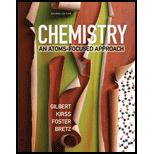
To find:
a. Limiting reactant in a reaction mixture of
(i)
(ii)
b. How many grams of
c. How much of which reactant is left over in the reaction mixture in part (i)?
Answer to Problem 7.81QA
Solution:
a. Limiting reactant in a reaction mixture of
b.
c.
Explanation of Solution
1) Concept:
Limiting reactant: It is defined as the reactant, which is completely consumed in the
Excess of reactant: The reactant, which is left over to some extent in unreacted form after completion of reaction.
Amount of excess of reactant can be calculated by subtracting the amount reacted from the initial amount of reactant.
i.e.,
Percent yield is the percent of amount of product formed.
i.e.,
where,
2) Formula:
3) Given:
i)
ii)
iii)
4) Calculation:
a. Limiting reactant:
Given reactions are:
i)
ii)
Reaction mixture contains
Calculate the moles of both
(To solve this problem, we need to consider
Calculate the mass of
The mole ratio between
The mole ratio between
(To solve this problem, we need to consider
(To solve this problem, we need to consider
The amount of
b. Mass of
From part a, we know that
From reaction (ii), the mole ratio of
This is the theoretical yield, but the yield from (ii) is 95%, so the formula for percent yield is
Re-arranging it for actual yield,
c. Mass of excess of reactant in reaction (i):
(To solve this problem, we need to consider
Calculate the mass of
Mole ratio of
(To solve this problem, we need to consider
Calculate the amount of
Therefore,
(To solve this problem, we need to consider
Conclusion:
We determined the limiting reactant from the reactant’s masses and found out the excess of reactant. Using the percent yield, actual yield is calculated.
Want to see more full solutions like this?
Chapter 7 Solutions
CHEMISTRY:ATOMS-FOCUSED..-ACCESS
 ChemistryChemistryISBN:9781305957404Author:Steven S. Zumdahl, Susan A. Zumdahl, Donald J. DeCostePublisher:Cengage Learning
ChemistryChemistryISBN:9781305957404Author:Steven S. Zumdahl, Susan A. Zumdahl, Donald J. DeCostePublisher:Cengage Learning ChemistryChemistryISBN:9781259911156Author:Raymond Chang Dr., Jason Overby ProfessorPublisher:McGraw-Hill Education
ChemistryChemistryISBN:9781259911156Author:Raymond Chang Dr., Jason Overby ProfessorPublisher:McGraw-Hill Education Principles of Instrumental AnalysisChemistryISBN:9781305577213Author:Douglas A. Skoog, F. James Holler, Stanley R. CrouchPublisher:Cengage Learning
Principles of Instrumental AnalysisChemistryISBN:9781305577213Author:Douglas A. Skoog, F. James Holler, Stanley R. CrouchPublisher:Cengage Learning Organic ChemistryChemistryISBN:9780078021558Author:Janice Gorzynski Smith Dr.Publisher:McGraw-Hill Education
Organic ChemistryChemistryISBN:9780078021558Author:Janice Gorzynski Smith Dr.Publisher:McGraw-Hill Education Chemistry: Principles and ReactionsChemistryISBN:9781305079373Author:William L. Masterton, Cecile N. HurleyPublisher:Cengage Learning
Chemistry: Principles and ReactionsChemistryISBN:9781305079373Author:William L. Masterton, Cecile N. HurleyPublisher:Cengage Learning Elementary Principles of Chemical Processes, Bind...ChemistryISBN:9781118431221Author:Richard M. Felder, Ronald W. Rousseau, Lisa G. BullardPublisher:WILEY
Elementary Principles of Chemical Processes, Bind...ChemistryISBN:9781118431221Author:Richard M. Felder, Ronald W. Rousseau, Lisa G. BullardPublisher:WILEY





